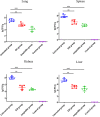Effective Antibacterial and Antihemolysin Activities of Ellipticine Hydrochloride against Streptococcus suis in a Mouse Model
- PMID: 33674433
- PMCID: PMC8117749
- DOI: 10.1128/AEM.03165-20
Effective Antibacterial and Antihemolysin Activities of Ellipticine Hydrochloride against Streptococcus suis in a Mouse Model
Abstract
Streptococcal toxic shock-like syndrome (STSLS) caused by the epidemic strain of Streptococcus suis leads to severe inflammation and high mortality. The life and health of humans and animals are also threatened by the increasingly severe antimicrobial resistance in Streptococcus suis There is an urgent need to discover novel strategies for the treatment of S. suis infection. Suilysin (SLY) is considered to be an important virulence factor in the pathogenesis of S. suis In this study, ellipticine hydrochloride (EH) was reported as a compound that antagonizes the hemolytic activity of SLY. In vitro, EH was found to effectively inhibit SLY-mediated hemolytic activity. Furthermore, EH had a strong affinity for SLY, thereby directly binding to SLY to interfere with the hemolytic activity. Meanwhile, it was worth noting that EH was also found to have a significant antibacterial activity. In vivo, compared with traditional ampicillin, EH not only significantly improved the survival rate of mice infected with S. suis 2 strain Sc19 but also relieved lung pathological damage. Furthermore, EH effectively decreased the levels of inflammatory cytokines (interleukin-6 [IL-6], tumor necrosis factor alpha [TNF-α]) and blood biochemistry enzymes (alanine transaminase [ALT], aspartate transaminase [AST], creatine kinase [CK]) in Sc19-infected mice. Additionally, EH markedly reduced the bacterial load of tissues in Sc19-infected mice. In conclusion, our findings suggest that EH can be a potential compound for treating S. suis infection in view of its antibacterial and antihemolysin activity.IMPORTANCE In recent years, the inappropriate use of antibiotics has unnecessarily caused the continuous emergence of resistant bacteria. The antimicrobial resistance of Streptococcus suis has also become an increasingly serious problem. Targeting virulence can reduce the selective pressure of bacteria on antibiotics, thereby alleviating the development of bacterial resistance to a certain extent. Meanwhile, the excessive inflammatory response caused by S. suis infection is considered the primary cause of acute death. Here, we found that ellipticine hydrochloride (EH) exhibited effective antibacterial and antihemolysin activities against S. suisin vitroIn vivo, compared with ampicillin, EH had a significant protective effect on S. suis serotype 2 strain Sc19-infected mice. Our results indicated that EH, with dual antibacterial and antivirulence effects, will contribute to treating S. suis infections and alleviating the antimicrobial resistance of S. suis to a certain extent. More importantly, EH may develop into a promising drug for the prevention of acute death caused by excessive inflammation.
Keywords: Streptococcus suis; antibacterial; antihemolysin; ellipticine hydrochloride; suilysin.
Copyright © 2021 American Society for Microbiology.
Figures






Similar articles
-
Amentoflavone Ameliorates Streptococcus suis-Induced Infection In Vitro and In Vivo.Appl Environ Microbiol. 2018 Nov 30;84(24):e01804-18. doi: 10.1128/AEM.01804-18. Print 2018 Dec 15. Appl Environ Microbiol. 2018. PMID: 30315078 Free PMC article.
-
Apigenin and Ampicillin as Combined Strategy to Treat Severe Streptococcus suis Infection.Molecules. 2021 Apr 1;26(7):1980. doi: 10.3390/molecules26071980. Molecules. 2021. PMID: 33915741 Free PMC article.
-
Ginkgetin in vitro and in vivo reduces Streptococcus suis virulence by inhibiting suilysin activity.J Appl Microbiol. 2019 Nov;127(5):1556-1563. doi: 10.1111/jam.14365. Epub 2019 Aug 15. J Appl Microbiol. 2019. PMID: 31260158
-
Biological activities of suilysin: role in Streptococcus suis pathogenesis.Future Microbiol. 2016 Jul;11:941-54. doi: 10.2217/fmb-2016-0028. Epub 2016 Jun 30. Future Microbiol. 2016. PMID: 27357518 Review.
-
Virulence factors involved in the pathogenesis of the infection caused by the swine pathogen and zoonotic agent Streptococcus suis.Future Microbiol. 2012 Feb;7(2):259-79. doi: 10.2217/fmb.11.149. Future Microbiol. 2012. PMID: 22324994 Review.
Cited by
-
Metabolomics and proteomics analyses revealed mechanistic insights on the antimicrobial activity of epigallocatechin gallate against Streptococcus suis.Front Cell Infect Microbiol. 2022 Sep 20;12:973282. doi: 10.3389/fcimb.2022.973282. eCollection 2022. Front Cell Infect Microbiol. 2022. PMID: 36204637 Free PMC article.
-
Antimicrobial and antivirulence function of cinnamaldehyde against Streptococcus suis type 2.Microbiol Spectr. 2025 Apr;13(4):e0256124. doi: 10.1128/spectrum.02561-24. Epub 2025 Feb 13. Microbiol Spectr. 2025. PMID: 39945529 Free PMC article.
-
High-throughput screening identification of apigenin that reverses the colistin resistance of mcr-1-positive pathogens.Microbiol Spectr. 2024 Oct 3;12(10):e0034124. doi: 10.1128/spectrum.00341-24. Epub 2024 Sep 9. Microbiol Spectr. 2024. PMID: 39248524 Free PMC article.
-
Theaflavin Ameliorates Streptococcus suis-Induced Infection In Vitro and In Vivo.Int J Mol Sci. 2023 Apr 18;24(8):7442. doi: 10.3390/ijms24087442. Int J Mol Sci. 2023. PMID: 37108608 Free PMC article.
-
9-Methoxyellipticine: Antibacterial Bioactive Compound Isolated from Ochrosia elliptica Labill. Roots.Metabolites. 2023 May 9;13(5):643. doi: 10.3390/metabo13050643. Metabolites. 2023. PMID: 37233684 Free PMC article.
References
-
- Segura M, Zheng H, de Greeff A, Gao GF, Grenier D, Jiang Y, Lu C, Maskell D, Oishi K, Okura M, Osawa R, Schultsz C, Schwerk C, Sekizaki T, Smith H, Srimanote P, Takamatsu D, Tang J, Tenenbaum T, Tharavichitkul P, Hoa NT, Valentin-Weigand P, Wells JM, Wertheim H, Zhu B, Gottschalk M, Xu J. 2014. Latest developments on Streptococcus suis: an emerging zoonotic pathogen: part 1. Future Microbiol 9:441–444. 10.2217/fmb.14.14. - DOI - PubMed
-
- Tohya M, Arai S, Tomida J, Watanabe T, Kawamura Y, Katsumi M, Ushimizu M, Ishida-Kuroki K, Yoshizumi M, Uzawa Y, Iguchi S, Yoshida A, Kikuchi K, Sekizaki T. 2017. Defining the taxonomic status of Streptococcus suis serotype 33: the proposal for Streptococcus ruminantium sp. nov. Int J Syst Evol Microbiol 67:3660–3665. 10.1099/ijsem.0.002204. - DOI - PubMed
Publication types
MeSH terms
Substances
LinkOut - more resources
Full Text Sources
Other Literature Sources
Medical
Research Materials

